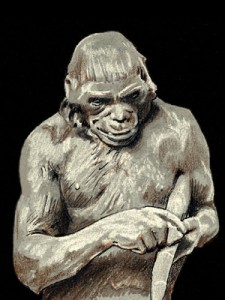
Certain features such as large jaws and wide hips indicate the australopithecus wasn't very far removed at all from creatures that foraged for nuts and berries and walked on all 4s, like high apes.

I believe they were the direct descendents of high apes who were forced to the ground and became more reliant on tools and communicating.

If we look at the contrasts between Australopithecus and Homo Habilis, what I just described basically outlines how they both came to exist, they are the 'missing links' in my opinion. Over time, they increased in height so they could see over grass and spot prey or predators, and their lower bodies changed to account for the stress put on the joints due to walking upright and natural selection of the ones who weren't efficient in their mobility. The change in diets and lifestyle would eventually lead to bipedal omnivores with smaller jaws and larger brains, these creatures were in groups that probably eventually developed some early forms of spoken language to communicate during hunts/scavenging or warn each other of threats. How I look at it is Eastern Africa went through a period of droughts and these beings lived primarily in trees, they were forced to the ground due to wildfires and drought, and thus meant they had to resort to omnivorous diets to keep up with the extra energy expended by moving to the ground.

Why do people even think there's a missing link? High apes have shown the capability of using crude tools like rocks and tree branches to accomplish tasks, have a societal structure that is pretty advanced, and the tendency to live in large groups with several males set the stage for a hunter/gatherer society.


 0 kommentar(er)
0 kommentar(er)
